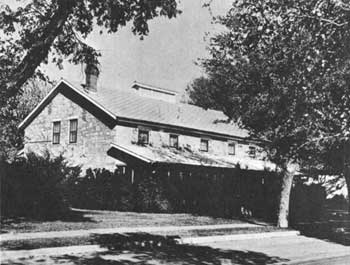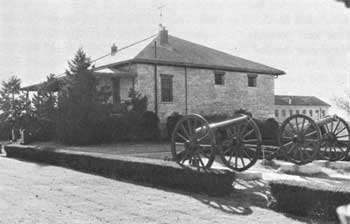





Survey of Historic Sites and Buildings
 |
FORT SILL Oklahoma |
 |
| ||
Founded in conjunction with a new Kiowa-Comanche Indian Agency near the base of the Wichita Mountains in March 1869 by General Sheridan during his 1868-69 campaign, Fort Sill played a significant part in the pacification of the southern Plains tribes and is still a major Army post today. Believing that the relocation of the fort and agency farther south on reservation lands and closer to the Texas frontier would facilitate Indian management, Sheridan founded the two installations to replace Fort Cobb and the Fort Cobb Agency, Okla., about 30 miles to the north. Later in the year the Kiowa-Comanche Agency absorbed the Wichita Agency, which had been located at Fort Cobb.
Duress soon yielded to humanitarianism. That same summer, Fort Sill was the site of an experiment in Indian management, a part of President Grant's Peace Policy. Grant inaugurated the policy in reaction to the cries of eastern reformers over the brutality of the Battle of the Washita, Okla., and other examples of Indian mistreatment. Hoping to end corruption on the reservations and to provide the Indians with examples of morality, he decided to appoint church-nominated men as Indian agents. Quakers, representing the denomination that responded most enthusiastically, were soon on reservation duty. The southern Plains, where the gentle Friends fell heir to some of the fiercest tribes in the West, became a testing ground for the "Quaker Policy."
 |
| Sherman House, Fort Sill. (U.S. Army, Department of Defense) |
Illustrating the problems the Quakers faced was the experience of Quaker Agent Lawrie Tatum. Arriving in July 1869 to take over the Fort Sill Indian Agency, he attempted immediately to transform his recalcitrant wards into peaceful farmers. Construing his solicitude as weakness, however, they continued their forays into Texas. They had little fear of punishment, for the Peace Policy forbade military interference on reservations unless requested by the agent. And, because Tatum refused to believe his charges guilty, the Fort Sill Reservation offered a refuge after each escapade. Their boldness growing in proportion to their success, they defied the Army to stop them. But in 1871 an unexpected turn of events dampened their ardor.
In May of that year a Kiowa war party from the Fort Sill Reservation, led by Satanta, Big Tree, and Satank, wiped out a wagon train near Jacksboro and Fort Richardson, Tex. Gen. William T. Sherman, inspecting Texas forts, narrowly missed a similar fate at the hands of the same party. Determined to put an end to Kiowa and Comanche hostilities, he moved on to Fort Sill. There he learned the Kiowa chiefs had bragged of their exploits on their return to the reservation. He had them arrested and sent to Fort Richardson, Tex., for incarceration pending an unprecedented civil trial. Satank, seeking to escape, was shot and killed en route. Satanta and Big Tree, serving only 2 years in prison, returned to Fort Sill late in 1873. The Kiowas lost no time in resuming their raids.
Their Comanche friends had not curtailed their activities. They continued to plague Texas until even Agent Tatum was forced to acknowledge their guilt. He reluctantly called on the Army to punish them, but in so doing incurred the displeasure of his more idealistic superiors. Discouraged, he resigned in March 1873. The Army welcomed an opportunity to chastise the Indians, but its small force could only show them that the Fort Sill Reservation was no longer a haven. The Indians were incensed over the loss of the lands they had ceded in treaties and the devastation wrought by the buffalo hunters, whisky peddlers, and horse thieves.
The failure of the Peace Policy to protect Texas settlers prompted the Army to revert to sterner measures. The Red River War (1874-75), against the Arapahos, Kiowa-Apaches, Comanches, Cheyennes, part of the Kiowas, and lesser tribes, was fought mainly in the Staked Plains of the Texas Panhandle and in Indian Territory (Oklahoma). Fort Sill was one of the major bases. The month after the Kiowas and Comanches attacked a group of buffalo hunters at Adobe Walls, Tex., General Sheridan ordered all professedly friendly Indians in the region to report to their agencies for registration. A severe drought delayed his operational plans until late summer, when 46 companies of infantry and cavalry took to the field. Columns from Fort Union, N. Mex., Fort Sill and Camp Supply, Okla., and Forts Concho and Griffin, Tex., gradually closed in on the Staked Plains, which be came a haven for fugitive bands.
 |
| Old Guardhouse, Fort Sill. (U.S. Army, Department of Defense) |
Although among the most comprehensive campaigns ever prosecuted against the Indians, the casualties on both sides were few. Involved was the sort of campaigning that General Sheridan viewed as the most effective and humane—relentless pursuit that kept the enemy always off balance, always on the move, always tormented by insecurity. Such tactics so damaged morale that surrender was but a question of time. The last fugitives gave up in the spring of 1875. The Army transported more than 70 Indian ring leaders from Fort Sill to Florida for imprisonment and placed their people back on the reservations. That same year Satanta was again sent to the Huntsville penitentiary in Texas, where he later committed suicide. Except for occasional raids by stray bands, the Red River War brought permanent peace to the southern Plains.
Fort Sill continued nevertheless as an active post. In 1894 Geronimo, his Chiricahua Apaches, and some of their Warm Springs kin, after their exile in Florida, were settled on the Fort Sill Military Reservation. Officially Geronimo was carried on the Army rolls as a scout, but he actually spent most of his time in retirement until his death in 1909. Four years later, 187 of the Chiricahuas were permitted to return to the Mescalero Reservation, N. Mex., and the rest stayed at Fort Sill. In 1905 the Army had extensively rebuilt the fort and expanded it into an artillery training and command center, which it has remained to the present.
The historic area of Fort Sill is open to the public. Nearly all the old stone buildings, built in the 1870's and 1880's and located to the east of today's main post, have survived and most are still in use. The U. S. Army Field Artillery Center Museum utilizes many of them. Only the cavalry stables have been torn down to make way for new construction. Of particular interest and dating to the 1870's are the headquarters building, used in that capacity until 1911; Sherman House, home of the post commandant and scene of the confrontation between Sherman and the Kiowa chiefs; the guardhouse, today a museum devoted to the military-Indian phase of history; and the chapel, the oldest house of worship in the State in continuous use since its founding. The old stone corral, a loop-holed stockade built in 1870 to the southeast of the old post, used to protect the fort's livestock and as a potential refuge in the event of Indian attack, now contains frontier transportation exhibits. Prominent Kiowa, Comanche, and Apache chiefs buried at the fort include Geronimo, Satank, Satanta, and Quanah Parker.
NHL Designation: 12/19/60
 |
 |
http://www.cr.nps.gov/history/online_books/soldier-brave/siteb25.htm
Last Updated: 19-Aug-2005